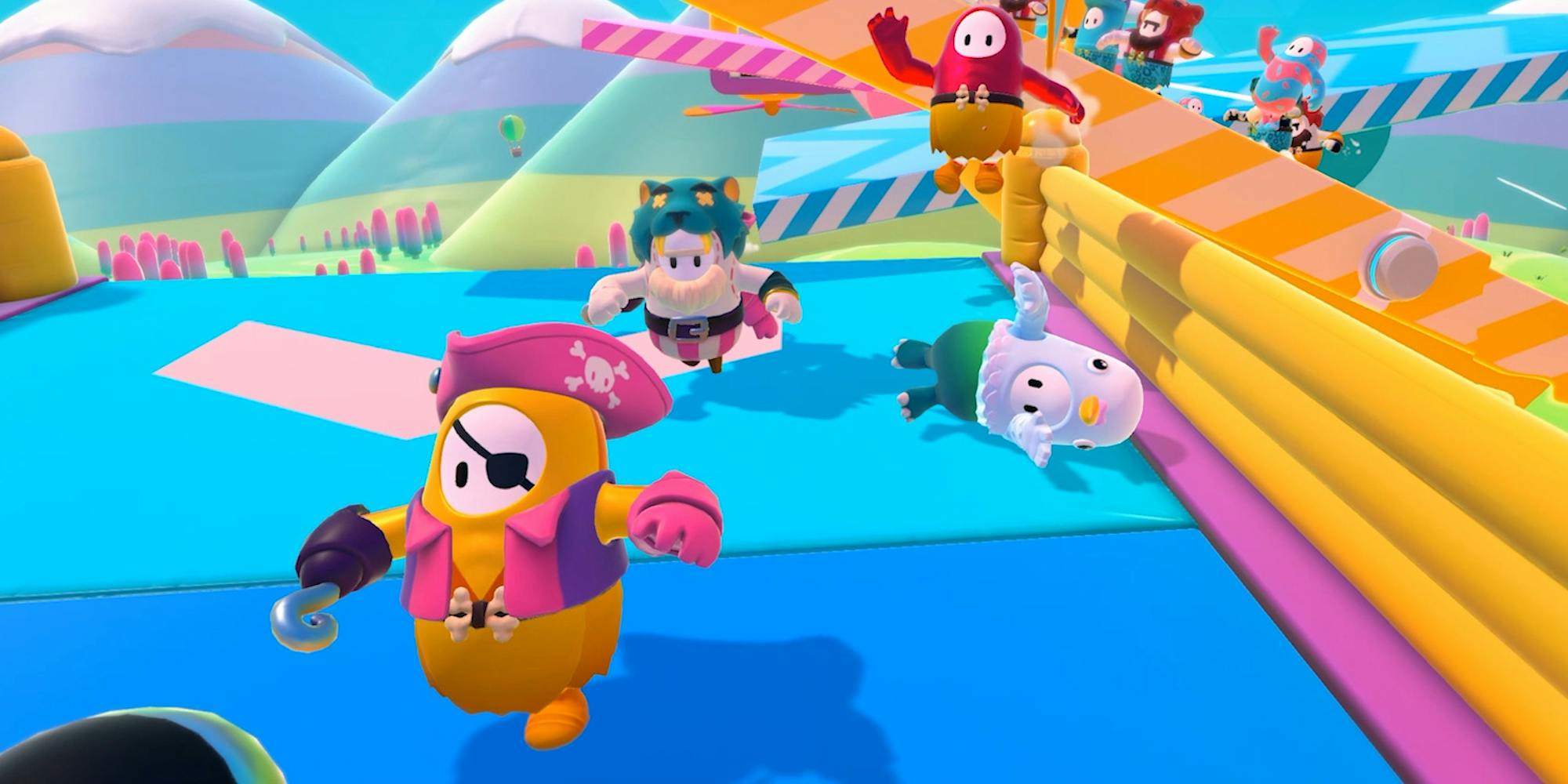Opinion
The other night, I threw on a pair of cat ears, grabbed a hand-me-down punk denim hoodie, and made history as the first sex worker to stream sex toy support for bean-based battle royale multiplayer game Fall Guys: Ultimate Knockout. Consider it part performance art, part cam show, and part zany online novelty.
The stream showed me using my We-Vibe Wish (the same toy I used for my Zoom porn shoot) while playing through several rounds of Fall Guys. In the stream, I redirected my DualShock controller’s rumble effects straight to my We-Vibe, so every time I jumped, fell, or ran into an obstacle, I got a nice little jolt that vibrated against my skin. Half of the stream involved me giggling and squirming, and the other half involved me fixing all of the Wish’s technical difficulties, of which there were many. But frustrations aside, it worked, and I streamed it, and I had a very fun time. (You can watch a short clip of my first round on ManyVids, although it’s obviously NSFW.)
All of this isn’t supported by Fall Guys nor We-Vibe right out of the box, however. Thanks to Kyle “qDot” Machulis’ open-source Buttplug.io programming library and his Intiface Game Haptics Router, I was able to redirect the controller rumble feature to my We-Vibe as I played. Fall Guys developer Mediatonic and publisher Devolver Digital probably weren’t expecting sex to be added to their bean-based multiplayer jump-’em’-up, but here we are.

Sex tech and games stories tend to elicit some interesting reactions. When Machulis hooked up the Buttplug software to Animal Crossing: New Horizons, it was received primarily with shock and disgust. But sex tech in games isn’t a new concept. Two decades ago, an Official PlayStation Magazine article outlined the history of sex in games. One entry, and perhaps the most noteworthy for centering cis women’s sexual experiences, included the Japan-exclusive Rez Trance Vibrator.
Years before Fall Guys was announced and nuanced sex-in-games discourse entered the mainstream games media world, USC Interactive Media and Games professor Miyuki Jane Pinckard wrote in detail about using the Trance Vibrator with her partner after picking up the game from Akihabara, Tokyo. The stark gonzo writing Pinckard brought to the table 20 years ago still shines in comparison to the tame, chaste nature of the contemporary games journalism world.
“But don’t you think this trance vibrator extension is so your girlfriend can get off while you’re playing the game? Or so a girl gamer can get off while she’s playing the game?” Pinckard asked her partner, to which he responded: “It was a bit odd, my fingers were working the controls, but they were also kind of working you.”
That’s kinky as hell. And also incredibly beautiful. When Wired contributor Julie Muncy returned to Rez’s Trance Vibrator in 2017, she cited Pinckard’s writing to talk about how games rarely consider female sexual pleasure, to the point where most commentary on it is either “pessimistic” or “reactionary.”
When Machulis introduced his sex toy features for Animal Crossing: New Horizons, gamers mocked the idea, perhaps because Animal Crossing is a game primarily played by female gamers. And whether we’re camgirls, Twitch streamers, or healsluts, women aren’t supposed to experience sexual pleasure from video games. This is despite the fact that women have long used rumble features for their own erotic, if not slightly awkward, pleasure.
“Ever since they invented the whole rumble pack/vibrating technology in controllers, [masturbation has] been on my mind, and sometimes in my practice (fellow game girls, you know what I’m talking about),” Pinckard wrote in 2002. “I did discover that Halo was a pretty good game for this (although for not much else), because as the gunner in the Warthog, you have unlimited ammo and you can just park yourself somewhere and rat-tat-tat to your heart’s content.”
There are, to be clear, an enormous number of ethical issues around inserting sex toys into your multiplayer games. During the stream, I didn’t really think much about why I wanted to keep colliding against other contestants or grabbing them (let alone being grabbed). Then, it dawned on me that I was engaging other players in an interaction that they hadn’t actually been fully informed about. That’s the in-game equivalent of hugging as many people as possible so you can feel your butt plug wiggle inside of you, which is not a great thing to do in public.
This sparked a much larger question about whether Fall Guys is even an appropriate game to play with a sex toy at all. While I’m inclined to think passively playing the game with an internet-of-things sex toy isn’t necessarily a problem, just as playing Overwatch with a dildo isn’t, actively grabbing players and bumping into them is a huge no-go. Use the tech responsibly.
“There’s no private lobbies or single player. It’s all public, all randos, all the time, and they can trigger haptics via holding or collisions,” Machulis wrote. “It is different than, say, wandering into a game with voice chat and putting your mic right next to the toy that’s reacting haptically to events from others. But it’s still, in the general sense, not a super clear cut great thing to be doing.”

My Fall Guys vibe days may be on pause, but as a queer sex writer, I’m still invested in our cultural understanding of what eroticism does (or in this case, doesn’t) look like. Games themselves are tools for pleasure, just as any form of play (intended or otherwise). That’s not to say all video games are sexual, let alone sex toys. But they are undeniably erotic because eroticism is about so much more than just physical sexual pleasure.
In Video Games Have Always Been Queer, Bonnie Ruberg defines eroticism as a sensual, aesthetic appreciation that comes from the oscillation of shared intimacy between yourself and another. Fall Guys’ tense elimination matches are nothing more than the oscillation “between near and far,” between “control and relinquishing,” between “being giver and receiver,” complete with delays that build to release, to paraphrase Ruberg’s inspiration Laura Marks.
In The Ethical Slut, Janet Hardy and Dossie Easton echo this point, saying eroticism pervades in “everything all the time.” We “inhale” and “exude” it by our sheer existence. And that includes play. “We think erotic energy is everywhere,” they write, “in the deep breath that fills our lungs as we step out into a warm spring morning, in the cold water spilling over the rocks in a brook, in the creativity that drives us to paint pictures and tell stories and make music and write books.”
Suddenly, many, many games take on this “erotic energy” too. In Doom Eternal, it’s the ero guro-esque glory kills. In Jackbox Party Pack 6’s “Push the Button,” it’s the titillating thrill of being a hunted Other. Buttplug.io’s previous viral demo, Animal Crossing, is perhaps the best example to date. A significant portion of the game is about the joy of being known, of being part of a community, of being one with a safe world where empathy comes first. Players engage in this eroticism by being social creatures and actively seeking out friendship with their fellow villagers. Many of the game’s characters receive suggestive artwork as a result, especially from queer furries and independent, female-friendly smut illustrators. That’s because Animal Crossing is fundamentally about connection between people—or people-like animals (marry me, Freya). And when intimacy emerges, eroticism soon follows.

You don’t necessarily need an open-source internet-of-things programming library to realize games are de facto sex tech in their own right. In fact, the most erotic gaming experience is happening right now on multiplayer games that aren’t compatible with Buttplug.io, such as Riot Games’ first-person shooter Valorant.
One of my favorite Valorant characters, Reyna, is a high femme supernatural chicana military agent who consumes the souls of her opponents. She is as drop-dead gorgeous as her voice lines are dripping with desire: She talks endlessly about how hungry she is, how her otherworldly cravings linger, how she wants more, more, more than she can ever have. This isn’t just a reflection of her gameplay role—she’s an entry fragger that only stays alive by killing as many opponents as possible—but the impetus for a deeply intimate experience playing as her or alongside her (let alone against her). My We-Vibe Wish doesn’t rumble when I play as Reyna, but when I hear her voice lines in-game, my thighs quiver just like when I played Fall Guys. Her dominant, monstrous presence is irresistible to a lesbian such as myself, and there’s a lengthy history of sapphic yearning over monstrous women to back up the point.
Throwing a vibe against your clit or placing a butt plug inside yourself may feel viscerally serene, but so is choosing your favorite character or performing a clean headshot and being rewarded with a femme domme line. That’s because play is intimate, and intimacy is erotic by nature. So why not unlock the parts of ourselves that drive us to connect, to engage, to play, and to make love with each other? Because if we accept all forms of play engage in eroticism, then we start to better understand why we play games in the first place.

